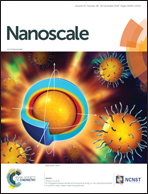Facile fabrication of configuration controllable self-assembled Al nanostructures as UV SERS substrates†
Abstract
The resonantly enhanced near-surface electromagnetic field of Al nanostructures (NSs) excited with UV light offers an effective and precise approach to obtain vibration information in complex mixtures up to a single-molecule magnitude. In this work, we propose a facile, cost-effective and large-scale way to fabricate self-assembled Al NSs with systematically controllable configuration and size for the preparation of SERS substrates. The stalagmite-shaped Al nanoparticles (NPs) are directly utilized based on the Volmer–Weber model and drastically develop as a function of the annealing temperature with tunable optical properties, resulting in a maximum enhancement factor of the vibrational Raman signal from adenine molecules up to 3.49 × 107. With a variation of the deposition thickness at an identical temperature, the self-assembled Al NSs sensitively evolve from stalagmite-shaped NPs to worm-like nano-mounds with increased light consumption induced by scattering, which inherently leads to a noticeable reduction in the EF due to the reduced plasmon coupling between NSs with the sparse distribution. The enhancement effect of the SERS substrates is theoretically discussed with the FDTD simulation, providing an instructive reference for promising applications in the bio-sensing technique.



 Please wait while we load your content...
Please wait while we load your content...